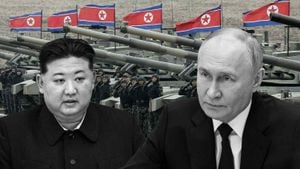The economic rivalry between the United States and China is increasingly asserting itself as one of the defining features of the global economy. With China’s recent endeavors to deploy thousands of satellites to create its own internet access network, alongside the U.S.’s efforts to bolster its industrial policies at home, the competition isn’t just about trade anymore; it’s about technology, security, and influence on the global stage.
China has recently laid out plans to surround the Earth with 13,000 satellites, which poses not just significant technological ambitions but also potential economic ramifications. This initiative, often referred to as the “Thousand Sails” constellation, aims to provide extensive internet access, rivalling Musk’s SpaceX and its Starlink satellite internet service. With over 4,500 satellites already deployed, Starlink currently leads the industry by providing broadband connectivity to underserved areas across more than 60 countries. Experts suggest this Chinese initiative could cater to several strategic objectives, including establishing autonomous digital infrastructure and enhancing remote military communications.
While this satellite constellation could revolutionize internet accessibility across the globe—particularly benefiting regions currently reliant on foreign networks—it also raises concerns over orbital congestion. The sky is getting crowded, and introducing 13,000 new satellites could heighten the risk of collisions and space debris. Already, thousands of satellites from various companies and governments send out signals from low-Earth orbit, making coordination and traffic management increasingly difficult.
Back on the ground, the U.S. has initiated policies to restructure its economy as it faces the dual challenge of China’s technological ascent and its own domestic economic needs. The COVID-19 pandemic has exacerbated trade imbalances, with the U.S. trade deficit widening and concerns growing about the sustainability of China's industrial policies, which seemingly bolster exports at the cost of local economies globally. Concerns have been raised about what some analysts are calling the potential for “China Shock 2.0,” where increased exports could displace workers internationally.
Analysts argue the U.S.-China dynamic is more complex than merely blaming one side or the other for economic challenges. Instead, they suggest focusing on macroeconomic fundamentals—including saving and investment patterns—can provide clarity as to why these imbalances exist. For example, after the pandemic, China's initially strong export market has fluctuated as domestic consumer confidence remains low, resulting from earlier lockdowns and struggles within its property market.
On the flip side, the U.S. economy, buoyed by significant fiscal spending, has remained dynamic, albeit at the cost of substantial government deficits and rising inflation. The distinct reactions to the pandemic within these two economies—the U.S. consuming more, bolstered by state spending, and China saving more, hampered by local economic fears—have significantly impacted the trade balances between the two nations. This divergence is now manifesting as unique economic challenges for each nation, prompting discussions about the longevity and efficacy of their respective recovery strategies.
China’s trade surplus has burgeoned as it continues to expand its market share and manufacturing capacity, marking it as the world’s leading manufacturer of electric vehicles (EVs). Last year, China produced about 8.9 million EVs and exported 1.2 million, leading the global market. This success, paired with the investment for future technologies and sectors, brings concerns about how this might threaten the competitive position of other nations, particularly the U.S.
To counter these rising economic challenges and improve industrial competitiveness, the U.S. may need to pursue adjustments at home, perhaps necessitating complicated discussions around austerity and investment priorities. Potential avenues for improvement could include raising taxes and reforming entitlement programs, which have been policies fraught with political contention. None of the presidential candidates seem focused on tackling fundamental adjustments to the economy, which could hamper the U.S.’s ability to respond effectively to shifting global dynamics.
On the regulatory front, differing approaches to technology and industrial policies under future administrations could impact everything from trade relations to national security. For example, under either President Kamala Harris or former President Donald Trump, efforts to bring manufacturing back to the U.S. and reduce dependencies on China are expected to be central themes. Yet, their methods diverge significantly. Harris may lean toward tightening regulations and enhancing renewable energy initiatives, whereas Trump would pursue broader tariff applications and deregulations to encourage direct investment, potentially increasing tensions with other global economic players.
Fundamentally, both nations are finding their economic policies increasingly intertwined as they navigate resources and markets globally. China's ambitions are not solely about rivalry, but also about seeking global connections and partnerships to secure its future. This includes plans to expand internet connectivity to improve accessibility, supported by their goal to accumulate significant digital infrastructure independent of Western influence.
While the highly visible competition between the U.S. and China plays to global narratives, it’s the behind-the-scenes impacts on everyday citizens and the world at large that's significant. The fortunes of workers, the shapes of markets, and the nature of international cooperation are all at stake. Such dynamics manifest not only through trade policies or manufacturing jobs but also through space technology, and how nations choose to invest resources has consequential effects globally.
China’s satellite internet ambitions signal its determination to step onto the world stage not just economically, but technologically, potentially redefining the future of connectivity. At the same time, the U.S. must grapple with its own fiscal health and how to bolster its industrial base amid competitive pressures from abroad. Moving forward, both nations are likely to intensify their economic rivalries, reshaping how nations interact with one another on the global stage, and altering the fabric of the international economy as we know it.



